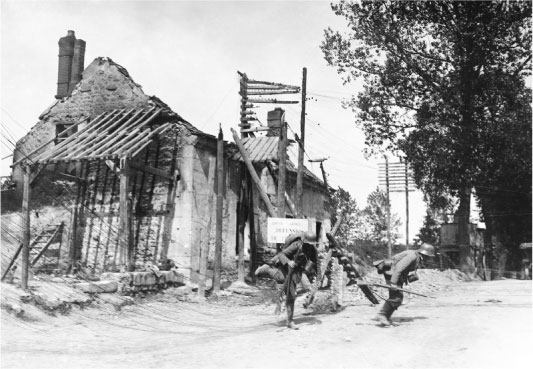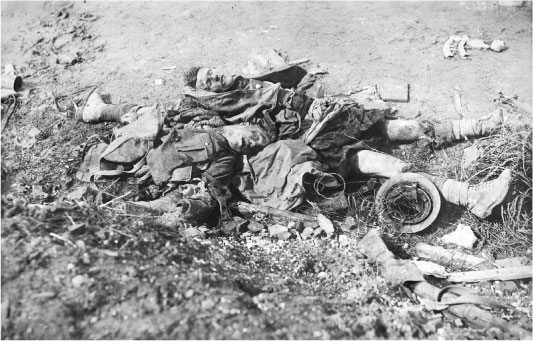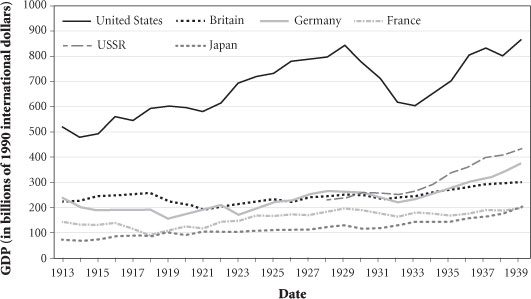War: What is it good for? (43 page)
Read War: What is it good for? Online
Authors: Ian Morris

Russia's collapse freed up half a million Germans to fight in the west before the American flood could arrive. But even more important, the fighting in Russia also showed how to solve the fundamental problem of command and control.
I have mentioned several times the military historian Victor Davis Hanson's theory of a Western way of war, stretching from ancient Greece to modern Europe and America, which wins battles with “a single, magnificent collision of infantry.” What the Germans discovered in 1917, though, was a “modern system” of war-fighting (as the strategist Stephen Biddle calls it) in which infantry does just the opposite, not colliding magnificently, but “reducing exposure to hostile fire”; seeking not concentration and shock but “cover, concealment, [and] dispersion.”
This modern way of war once again revolutionized military affairs. It tapped into the energies of people's war by pushing initiative down the ranks, into the hands of noncommissioned officers and even individual storm troops (as Germans called the new kind of soldier). Given proper training, these men could be relied on to exercise their own initiative without officers around to drive them forward. Small groups would sneak across no-man's-land, rushing through the killing fields by exploiting shell holes, tree stumps, and whatever other cover survived (
Figure 5.6
).

Figure 5.6. To the green fields beyond: German storm troops infiltrating through the ruined French village of Pont-Arcy, May 27, 1918
Storm troops carried light but powerful weaponsâthe first submachine guns and flamethrowersâbut the modern way of war was not about technology. It was about surprise. Instead of intense shelling, giving the game away, attacks now opened with short blasts of gas, enough to sow confusion among defenders scrambling to fit their masks (“Gas! Gas! Quick, boys!âAn ecstasy of fumbling, / Fitting the clumsy helmets just in time”), but not enough to give them time to prepare for what was coming. The storm troops then infiltrated into the trenches, bypassing well-organized defenders and crawling forward to find command posts and artillery. These they hit hard, decapitating the enemy organization and throwing everything into confusion. For most of the defenders, the first sign of trouble was shooting coming from
behind
them.
By then, a second wave of Germans was already assaulting the strong-points left behind by the first, but when all went well, this was not even necessary. Surrounded, getting no orders, and with no idea where the real battle was happening, armies regularly ran away or gave up. A British officer who had been on the receiving end of the new German tactics called the effect “strategic paralysis.” “To attack the nerves of an army, and through its nerves the will of its commander,” he learned, “is more profitable than to batter to pieces the bodies of its men.”
The first time the Germans tried storm-troop warfare, at Riga in September 1917, the entire Russian line collapsed. At Caporetto in Italy six weeks later, the panic (immortalized in Ernest Hemingway's novel
A Farewell to Arms
) was even more overwhelming. At one point, one German lieutenantâErwin Rommelâcaptured fifteen hundred Italians with the help of just five of his own men. In all, a quarter of a million Italians surrendered, and the Germans and Austrians surged forward sixty miles.
These, though, were just rehearsals. By the end of 1917, the only thing that mattered was caving in the Western Front before too many Americans arrived. Ludendorff saw no option but to bet the house on breaking the British line, pushing the globocop's troops back into the Channel ports,
and driving the French to the negotiating table. In March 1918, he rolled the dice one last time.
Just two days into the attack, the British Fifth Army folded. Thousands of men threw away their rifles and ran, leaving thousands more behind them, permanently (
Figure 5.7
). The kaiser gave every schoolchild in Germany a victory vacation, but unlike at Riga or Caporetto, this time the defenders kept their heads and rushed reserves into the gap. As the German advance slowed to a crawl, Ludendorff attacked a new section of the line, and in early May the British position was once more critical. “With our backs to the wall,” the order came down, “and believing in the justice of our cause, each one of us must fight on to the end ⦠There must be no retirement.”

Figure 5.7. Some corner of a foreign field that is forever England: British dead at Songueval, March 1918
There was in fact quite a lot of retirement, but the British again blunted the attacks. Ludendorff made another push, pressing the French so hard that Americans, fresh from the Atlantic crossing, had to be thrown in. The French fell back, recommending that the U.S. Marines follow them, only to receive the immortal reply: “Retreat? Hell, we just got here.” The position held. Ludendorff had lost.
It was now the Germans who buckled under the weight of attrition. Each side lost around half a million men in the spring of 1918, and a hor
rendous new enemy, Spanish influenza, was raging through both armies (the H1N1 virus probably evolved in crowded army camps in 1917â18 and killed fifty million to a hundred million people by the end of 1919). But while the Allies could replace their casualtiesâ700,000 Americans were already in France, with twice as many more on the wayâGermany could not. The Anglo-Franco-American alliance planned huge new offensives for 1919, talking of parachute drops far behind German lines and armored breakouts using thousands of tanks (although whether the planes and tanks of 1919 were up to this remains an open question), but in the end Britain's old Plan Bâof starving the enemy into submissionâbeat these grandiose schemes to the finish line. In the fall of 1918, famine gripped Germany. Soldiers and sailors mutinied. Bolsheviks seized cities. Civil war began.
At the front, German soldiers began giving up in huge numbers. Americans netted 13,251 in a single day, and between April and October 1918 the German army shrank by a million men. Ludendorff had a breakdown at the end of September; the kaiser fired him and then fled into exile. Finally, on November 11, the shooting stopped on the Western Front. “At eleven o'clock this morning,” Prime Minister David Lloyd George told Parliament, “came to an end the cruellest and most terrible war that has ever scourged mankind. I hope we may say that thus, this fateful morning, came to an end all wars.”
Peace Without Victory
Why was Lloyd George so badly wrong? Some blame the Treaty of Versailles for being too harsh, leaving Germany seeking revenge. Others blame it for being too soft, leaving Germany intact instead of reversing its 1871 unification. Others still blame the U.S. Congress for refusing to ratify the treaty or Britain and France for scheming to exploit it. The truth, though, is much simpler. Real peace required a strong globocop.
Germany had not gotten the counterproductive war it wanted, which would have broken up the European alliance against it and crippled the British globocop, but neither had Britain gotten a productive war restoring its pre-1870 prominence. Britain came out of the war virtually untouched by shot, shell, or bomb, with an economy second only to the United States', with the largest fleet in the world, and, after gobbling up various German colonies, with an empire that ruled roughly a quarter of the planet. But the price of victory had been ruinous. More than a third of a millennium had passed since Pepys had grumbled that “want of money puts all things, and
above all things the Navy, out of order,” but it was even truer in 1919 than it had been in 1661. Britain's debts were twice as large as its gross national product. They were smaller than the burden the nation had borne after the wars against Napoleon, to be sure, but in 1815 Britain had been the world's only industrializing economy, and in 1919 it was not. Nineteenth-century Britain, its GDP growing by leaps and bounds, had steadily paid down its debt, but trying to repeat that feat in the twentieth century by slashing spending and raising taxes only brought on recession.
By 1921, British unemployment was over 11 percent, and inflation passed 21 percent. Strikes wasted eighty-six million workdays, and the economyâwhich had shrunk by nearly a quarter since the war ended (
Figure 5.8
)âwas smaller than it had been in 1906. Deep spending cuts drove the chief of the Imperial General Staff to despair that “in no single theatre are we strong enoughânot in Ireland, nor England, nor on the Rhine, nor in Constantinople, nor Batoum, nor Egypt, nor Palestine, nor Mesopotamia, nor Persia, nor India.” Unable to fund its fleet, Britain accepted naval parity with the United States in 1922, achieved by voluntarily scrapping more ships than the Royal Navy had ever lost in a battle. “We cannot alone act as the policeman of the world,” the leader of the Conservative Party conceded.

Figure 5.8. The shape of unknown unknowns: the wild rides of the world's economies, 1913â39 (Soviet figures are unreliable before 1928)
The United States, on the other hand, supported its mega-fleet while spending just 1 percent of GDP on defense, because American output surged steadily upward in the 1920s while other economies struggled through
boom-and-bust cycles. By 1929 American foreign investment had almost matched Britain's peak level of 1913, and its global trade was worth 50 percent more. “The change since 1914 in the international position of the United States,” the
New York Times'
financial editor noted in 1926, was “perhaps the most dramatic transformation of economic history.”
The United States seemed ready to drive Britain out of its job as globocop, but this was the last thing on most Americans' minds. Some adhered to Thomas Jefferson's hope for “peace, commerce, and honest friendship with all nations, entangling alliances with none”; others worried more about avoiding entangling expenses; but others still, including President Woodrow Wilson, dreamed of something completely different.
The goal of fighting, Wilson told the Senate in January 1917, must be “peace without victory,” because “victory would mean peace forced upon the loser, a victor's terms imposed upon the vanquished.” As Wilson saw it, “only a peace between equals can last,” meaning that “the guarantees exchanged must neither recognize nor imply a difference between big nations and small, between those that are powerful and those that are weak.” In place of one mighty empire acting as globocop, Wilson proposed a league of nations, “a single and overwhelming powerful group of nations who shall be the trustee of peace in the world.”
On the face of it, this did not look so new. Kant, of course, had talked about something similar, and just a few years before Wilson's speech the former president Theodore Roosevelt had suggested replacing the old-fashioned globocop with a kind of community globocop, in which “the efficient civilized nationsâthose that are efficient in war as well as in peaceâshall join in a world league for the peace of righteousness ⦠to act with the combined military strength of all of them against any recalcitrant nation.” Some even imagined an international air force that would bomb aggressors to the negotiating table.
